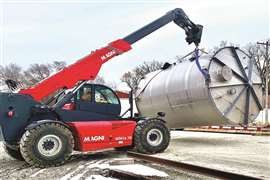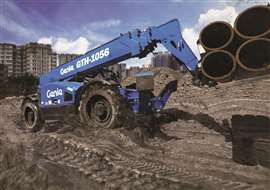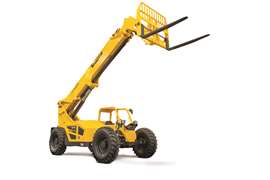High-capacity telehandlers do the heavy lifting
19 August 2024
“We see the market as being strong and are experiencing an upward trend compared to the same period last year,” says Gary Weisman, COO of Magni America, of high-capacity telehandlers. “The southeast and Texas are showing the greatest demand. This is due to the presence of ‘mega projects,’ the energy sector and population demands.”
High-capacity telehandlers – or units that can lift 10,000 pounds or more – are primarily utilized in all types of construction, mining, oil and gas and heavy industrial sectors. 10K and 12K models are seen on most any construction site and these heavy lifters perform various critical tasks, including handling steel at large construction sites, assisting with the maintenance of mining equipment and transporting large transformers for electric companies.
Weisman says the units’ ability to pick and place massive loads is why they remain a top-pick for equipment rental companies and contractors.
 High-capacity telehandlers are those that can lift 10,000 pounds or more. (Photo: Magni America)
High-capacity telehandlers are those that can lift 10,000 pounds or more. (Photo: Magni America)
“Growth is particularly notable in North America, driven by a surge in large-scale construction projects, infrastructure development and the expansion of the renewable energy sector,” Weisman notes. “Over the past year, there has been a significant uptick in their usage within the energy sector, oil and gas industry and major construction projects. Notably, there has been an increased deployment of these machines in the development of battery chip plants in the United States.”
Magni recently introduced its HTH 12.10 model, which features a maximum lifting capacity of 26,455 pounds and a maximum lift height of 31 feet, 2 inches. Positioned between Magni’s HTH 10.10 model, with a 22,000-pound lifting capacity, and the HTH 16.10 model, with a 35,200-pound lifting capacity, the HTH 12.10 filled a gap in Magni’s product lineup, Weisman says.
Daliborka Ribeiro, director of product management — telehandlers, JLG, echoes these sentiments.
Big demands call for big machines
“Despite the constraints of the global economic landscape over the past few years, the market for high-capacity telehandlers continues to show remarkable resilience, maintaining a steady demand and promising future growth,” Ribeiro says, noting the increased demand for higher-capacity telehandler models can be attributed to the growing size and scale of materials being handled.
“For instance, the rise of the online consumer base has led to the development of large-scale distribution and warehousing facilities, each spanning at least 200,000 square feet.
These industrial projects necessitate the use of larger building materials, requiring equipment that can maneuver the busy job site without compromising lift capacity. This has led to a greater demand for
 The increased demand for higher-capacity telehandler models can be attributed in part to the growing size and scale of materials being handled. (Photo: JLG)
The increased demand for higher-capacity telehandler models can be attributed in part to the growing size and scale of materials being handled. (Photo: JLG)
telehandlers to support heavy lifting and placing tasks. Telehandlers are typically one of the first machines on a job site and among the last to leave.
High-capacity telehandlers enable users in these applications to save time, money and labor by allowing operators to accomplish multiple tasks with a single machine. For instance, a 16,000-pound capacity unit can lift 33% more than a 12,000-pound capacity model, enabling the operator to move more material quickly and move on to the next job sooner than with the smaller model.”
Today, high-capacity telehandlers are being utilized to perform tasks that were traditionally carried out by small rough-terrain cranes, excavators and wheel loaders equipped with forks. This shift improves productivity due to advantages such as compactness, mobility, maneuverability, speed, lift height and forward reach, Ribeiro says.
“For years, higher-capacity telehandlers maxed out at a 12,000 pounds of lift capacity, but now, the industry sees models with capacities ranging from 14,000 to 45,000 pounds,” she notes.
JLG offers three high-capacity models: The 1644 with a maximum lift capacity of 15,650 pounds; The 1732 with a maximum lift capacity of 16,755 pounds and; The 2733 with a maximum lift capacity of 26,600 pounds.
JLG’s high-capacity telehandlers are also available with optional SmartLoad technology, an advanced bundle of three integrated technologies that work together to deliver greater operator confidence, the company says. “Armed with real-time load data, this package provides operators with increased confidence while fleet owners avoid the costly repairs that may result from machine overloading.”
The bundle includes: Automatic attachment recognition, load management information systems and load stability indicators.
But what’s it gonna cost?
Rental companies are looking for telehandlers that will stand up to the realities of the job site – and one major area of importance (in terms of innovation) is total cost of ownership.
 Increased investment in infrastructure is fueling demand for high-capacity telehandlers. (Photo: Genie)
Increased investment in infrastructure is fueling demand for high-capacity telehandlers. (Photo: Genie)
Amalija Kopac, senior global product manager, Genie, says demand for telehandlers in general has continued to grow exponentially. And current market demand for high-capacity telehandlers, in particular, is strong.
“A big part of that is due to continued investments in infrastructure,” Kopac notes. “Across the U.S., there is a big push to address aging and deteriorating infrastructure and construct housing. That is driving the need for telehandlers in general, and high-capacity telehandlers in particular, because of their versatility.
“Demand also is growing because more people are aware of how beneficial it is to have a telehandler on the job site. If you think about it, telehandlers were niche machines just a decade ago. Few people knew what they were, why they needed one, or just how much a telehandler could do. I think it’s safe to say the secret is out now.”
Since 2021, Genie has introduced two new telehandlers: a redesigned 10k telehandler, the Genie GTH-1056, and the new GTH-1256 12k telehandler. Both models were designed, built and tested for durability and performance and incorporated feedback from customers, Genie says.
About 75% of the parts for the GTH-1256 are in common with components in the rest of the product line, Kopac says.
“This simplifies maintenance and reduces the number of parts a rental company needs to stock,” Kopac says. “Operationally, the models are also similar, which makes training and service seamless. By keeping the designs simple, technicians know what to expect regardless of the model.”
Genie’s Quick Attach system makes it easy and fast to swap attachments. According to Kopac. The GTH-1256 shares attachments with Genie’s GTH-1056 10k telehandler, including three carriage sizes, a rotating carriage and a swing carriage. “This ease-of-use and commonality of attachments gives fleet owners an opportunity to increase the versatility of their fleet in a cost-effective manner, contributing to lower costs and a better ROIC.”
At the 2024 ARA Show, Genie introduced new attachments for the telehandler family.
“Attachments are what make telehandlers the versatile tool carriers that contractors love and what expands fleet utilization for rental companies.” Kopac says. “For these two high-capacity telehandlers, contractors can swap forks for a truss boom and two multi-purpose buckets. In addition, two new carriage options increase load handling flexibility. The truss boom, buckets, and carriage options will be available in spring 2024.”
More attachments, additional flexibility
Tim Palosaari, Pettibone’s product management analyst, says the Michigan-based company is seeing “significant growth” for high-capacity telehandlers “in all the usual markets, including rental and construction.
 As builders continue to battle rising development costs, it raises the need for greater efficiency, which high-capacity telehandlers can offer. (Photo: Pettibone)
As builders continue to battle rising development costs, it raises the need for greater efficiency, which high-capacity telehandlers can offer. (Photo: Pettibone)
“As builders continue to battle rising development costs, it raises the need to become more efficient,” Palosaari notes. “Having a telehandler on your building site is a quick way to improve that efficiency.”
While telehandlers continue to be used in construction applications primarily, there continue to be new applications where these machines are utilized as people become accustomed to operating them.
“In many cases, users are exploring new ways to use telehandlers because they can utilize several different attachments,” Palosaari says. “This makes the telehandler more of a multi-tool that can replace the need for other specialty equipment.”
Pettibone will be launching a new Extendo 1536X model, which offers up to 15,000 pounds max load capacity and features a two-section boom, soon, Palosaari says.
“This model’s design is compatible with some ground-engaging attachments, which allows for increased utilization in many markets. Being able to pick up dirt and debris while still being able to lift up to 36 feet makes it a versatile machine,” he adds.
Getting techy – and its impact
“Any technology that contributes to drive ROI will be popular in 2024,” says Malcolm Early, VP of marketing, Skyjack. “Machine reliability and longevity, as well as flexibility for fleet movement, are increasingly important.”
 Experts speculate about growing interest in telehandlers in Asia (China), where the wheel loader has a strong presence. (Photo: Skyjack)
Experts speculate about growing interest in telehandlers in Asia (China), where the wheel loader has a strong presence. (Photo: Skyjack)
Skyjack’s telehandlers use SKYCODED, a “proven and simplistic control system using our color coded and numbered wiring system to make our machines the easiest to troubleshoot. Using a relay-based control system allows Skyjack’s telehandlers to operate with simpler components resulting in less maintenance and lower costs,” Early notes.
“Advances that incorporates flexibility, such as FLEXCAB, will also be impactful in the coming years to allow for fast response to rental customer demands. FLEXCAB is an innovative cab design that allows fleet operators to easily convert between open and enclosed cabs with simple hand tools, providing increased flexibility for fleet movement and fast response to customer demands. “
According to Early, the latest Skyjack models have increased machine reliability and longevity, while continuing to offer best in class serviceability. Features and improvements include:
- A new dual-tilt compensation cylinder design improves load distribution and reliability
- New maintenance-free (greaseless) main bearings
- A relocated ECU for easier service access
- A new high-pressure filter system and improved hydraulic tank design – significantly reducing contamination
- New durable and rental yard repairable steel engine cowling
- New ergonomic seat with improved weather protection
“Certainly, the market in 2023 was very positive and looks promising for 2024,” Early adds. “There is talk of interest in telehandlers in Asia (China). The questions really revolve around whether this is in terms of export from China to traditional western markets or a change of emphasis within China, where the wheel loader has a strong presence.
“The extent to which that market will move toward palletized loads is then the next question. The debate will then be on which style of telehandler – the North American style or the European style.”
Launches and further improvements
At ConExpo, Manitou launched five new MTA series telescopic handlers designed in South Dakota for the North American market: The MTA 642, MTA 842, MTA 1055, MTA 1242 and the MTA 1255.
These new models replace the larger MTA models with maximum lifting capacities between 6,000 and 12,000 pounds and lift heights between 42 feet to 55 feet, 7 inches. The MTA 842 and MTA 1055 feature a 74 HP or a 127 HP engine to match engine power for customer needs.
“The new MTA line-up offers improved visibility, enhanced comfort and performance, and a lower total cost of ownership,” according to Manitou. “The range has been completely redesigned with a new cab, reconfigured engine compartment, simplified maintenance, more ground clearance, automatic parking brake, automatic transmission, and a new in-cab display all encompassing the durability and reliability similar to MTA Series IV units.”
Steve Kiskunas, Manitou’s US telehandler product line manager, explains, “We have done a great deal of work on the comfort and performance of this new range. The new piston pump and flow sharing system improves smoothness and accuracy, and the combined hydraulic movements provide greater efficiency for increased productivity.
“The new transmission’s automatic mode offers greater flexibility and optimum torque with less operator fatigue, with the option to switch to standard powershift transmission at any time. Manitou has also worked on reducing TCO with more robust components for better residual value. Design innovations have also been introduced, including easier access to the engine, reducing preventive maintenance costs by 8.7% compared to the previous range.”
JCB, which has just broken ground on a new manufacturing facility in Texas for its North American line of products, offers a range of high-capacity models, with maximum lifting caps resting between 10,000 and 14,000 pounds. On the heavier end is JCB’s 514-56 Loadall.
The 514-56 Loadall is a purpose-built machine designed for heavy lift-and-carry applications, particularly in oil and gas drilling and wind farm applications, the company says. It is equipped with a chain-driven, four-stage extension boom with beefed up inner and outer boom assemblies to accommodate loads up to 14,000 pounds. The carriage is direct mounted onto the boom for added load strength.
To ensure stability at height, the new model includes a heavier counterweight and a wider stabilizer pack, providing better lateral and longitudinal stability. The 514 also comes with a 20-ply tire rating to handle heavier-axle loading, larger tilt and displacement rams and standard rear axle stabilization. A compact wheelbase and two-wheel, crab and four-wheel-steer modes ensure optimal maneuverability while roading or moving material around the job site.
With the market in high demand, and new technology improving telehandlers’ capabilities, keep your eyes peeled for new launches that surely will take place in the coming year.
To spin or not to spinWill rotating telehandlers ever replace fixed-boom, high-capacity units? ALH asked the OEMs, here’s what they had to say. Amalija Kopac, senior global product manager, Genie - This isn’t likely. Rotating telehandlers are more complex to own, maintain and operate. There is a place for them in the market, but they really do serve different needs. Rotating telehandlers are more popular in Europe because their cities and infrastructure tend to be built with tighter sites, so rotating telehandlers have grown to suit that type of application. Daliborka Ribeiro, director of product management, telehandlers, JLG - Both rotating telehandlers and fixed-boom, high-capacity telehandlers have their place on job sites. High-capacity telehandlers are preferred for their pick-and-carry power and maneuverability on busy job sites, while rotating telehandlers excel in stationary tasks, offering high lift capabilities and capacities for pick-and-place requirements. Having both machines on the job site is ideal for maintaining high productivity without compromising operator or machine availability. Thanks to their maneuverability, speed and forward reach, high-capacity telehandlers may replace more traditional machines, such as wheel loaders, in certain applications where greater reach is desired. The advantages of high-capacity telehandlers over traditional equipment include versatility in terms of lift height and forward reach, a compact footprint and travel speed. Tim Palosaari, product management analyst, Pettibone - No, there will always be a place for fixed-boom machines, which are significantly lower in cost. Fixed-boom telehandlers also don’t require the use of outriggers, which allows operators to quickly get in and out when delivering loads. Rotating models work well, although they still need to be fed materials by other machines in order to avoid repeat setups. Gary Weisman, COO, Magni America - While rotators will not replace fixed booms, they certainly are better suited for certain job sites by offering increased efficiency and productivity. At Magni, with over 100 attachments, a rotator serves as several machines in one. They are great when performing repetitive tasks and can often take the place of a crane. Heavy-duty fixed-boom models will continue to be indispensable for tasks requiring maximum lift capacity and straightforward operation. |
STAY CONNECTED



Receive the information you need when you need it through our world-leading magazines, newsletters and daily briefings.
CONNECT WITH THE TEAM






